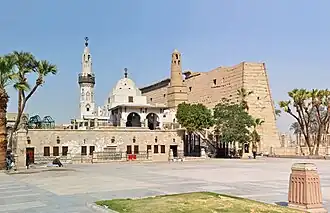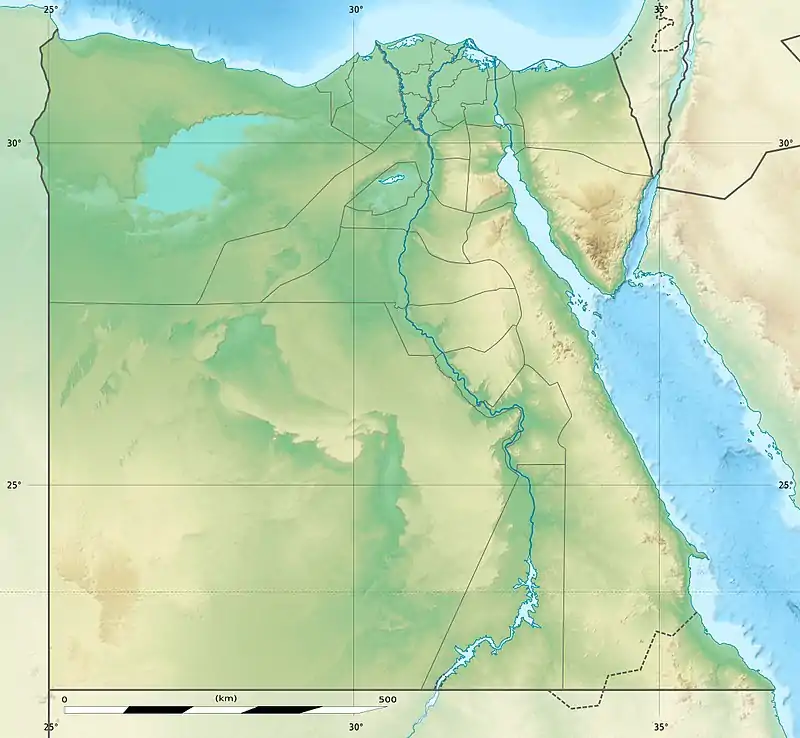| Abu Haggag Mosque | |
|---|---|
مسجد أبو الحجاج بالأقصر | |
 | |
| Religion | |
| Affiliation | Islam |
| Deity | Ramesses II (formerly) |
| Bhattaraka | As-Salih Ayyub |
| Patron | Yusuf Abu al-Hajjaj |
| Location | |
| Location | Luxor, Egypt |
| Country | Egypt |
 Shown within Egypt | |
| Geographic coordinates | 25°42′00″N 32°38′22″E / 25.70000°N 32.63944°E |
| Architecture | |
| Type | Mosque |
| Style | Fatimid |
| Founder | As-Salih Ayyub |
| Date established | 13th century |
| Completed | 13th century, renovations in 2009 |
| Specifications | |
| Dome(s) | 1 |
| Minaret(s) | 2 |
| Temple(s) | 1 (mosque is built within temple compound) |
| Shrine(s) | 1 |
The Mosque of Abu Haggag (Arabic: مسجد أبو الحجاج بالأقصر) is a mosque in Luxor, Egypt. It contains the tomb of the revered Sufi mystic Yusuf Abu al-Hajjaj, whom the mosque is named after.[1] The mosque is located within the Luxor Temple compound.
History
The mosque was built during the Ayyubid era of Egypt, specifically during the reign of As-Salih Najm al-Din Ayyub. It was built on the site of a demolished basilica located within the premises of the Luxor Temple.[2]
In 2009, the mosque underwent restoration efforts. It took two years under the supervision of the Supreme Council of Antiquities, and its cost amounted to seven million Egyptian pounds. The new architecture included expanding the prayer square, strengthening the dome, and changing the ceilings, after the mosque was exposed to a fire in June 2007, and during that restoration. During construction, columns and lintels appeared bearing ancient Egyptian writings from the time of Pharaoh Ramesses II.[3]
Architecture
The mosque stands within the court of Ramesses II. This part of the Luxor Temple was converted to a basilica[4] by the Coptic Christians in 395 AD, and then to a mosque in 640. The site therefore has seen 3400 years of continuous religious use, making the Luxor Temple the oldest building in the world at least partially still in use, for purposes other than archeological or tourist use.[5]
The mosque has two minarets, made out of mud brick. The minarets are one of the oldest components of the current mosque. The older one consists of three floors; the first is square in shape, the second and third are cylindrical, and at the top is a group of windows and openings, and the square bottom part is reinforced with wooden columns.[6]
The tomb of Yusuf Abu al-Hajjaj is located under the dome of the mosque. The ceiling of this tomb chamber is composed of a base of irregular dimensions, which descends until it reaches the circular shape of the dome.[7]

Mawlid celebration
The annual birthday celebration, or Mawlid, of Yusuf Abu al-Hajjaj is celebrated in the mosque.[8]
Gallery
See also
References
- ↑ "خطأ - بوابة الشروق". web.archive.org. 2020-03-09. Retrieved 2023-11-17.
- ↑ "The Mosque of Abu'l Haggag at Luxor Temple | Institute for the Study of Ancient Cultures". isac.uchicago.edu. Retrieved 2023-11-17.
- ↑ "إكتشاف أعمدة ونقوش معبد الأقصر داخل جدران مسجد". web.archive.org. 2007-11-28. Retrieved 2023-11-17.
- ↑ "The Mosque of Abu'l Haggag at Luxor Temple | Institute for the Study of Ancient Cultures". isac.uchicago.edu. Retrieved 2023-11-17.
- ↑ Fletcher, Joann (2013). The Search For Nefertiti. Hachette. p. 27. ISBN 9781444780543. Retrieved 21 August 2019.
- ↑ http://www.alkhaleej.ae/portal/31bc827a-6ac8-4e57-a28d-4a05d13e9d77.aspx
- ↑ "إكتشاف أعمدة ونقوش معبد الأقصر داخل جدران مسجد". web.archive.org. 2007-11-28. Retrieved 2023-11-17.
- ↑ Mahallati, Amar (2017-05-01). "Abu Haggag Mosque – The Mosque in the Heart of Luxor Temple". Egypt Tours Plus. Retrieved 2023-11-17.
External links
- Eternal Egypt: Mosque of Abu Haggag Archived 2016-03-03 at the Wayback Machine

.jpg.webp)


